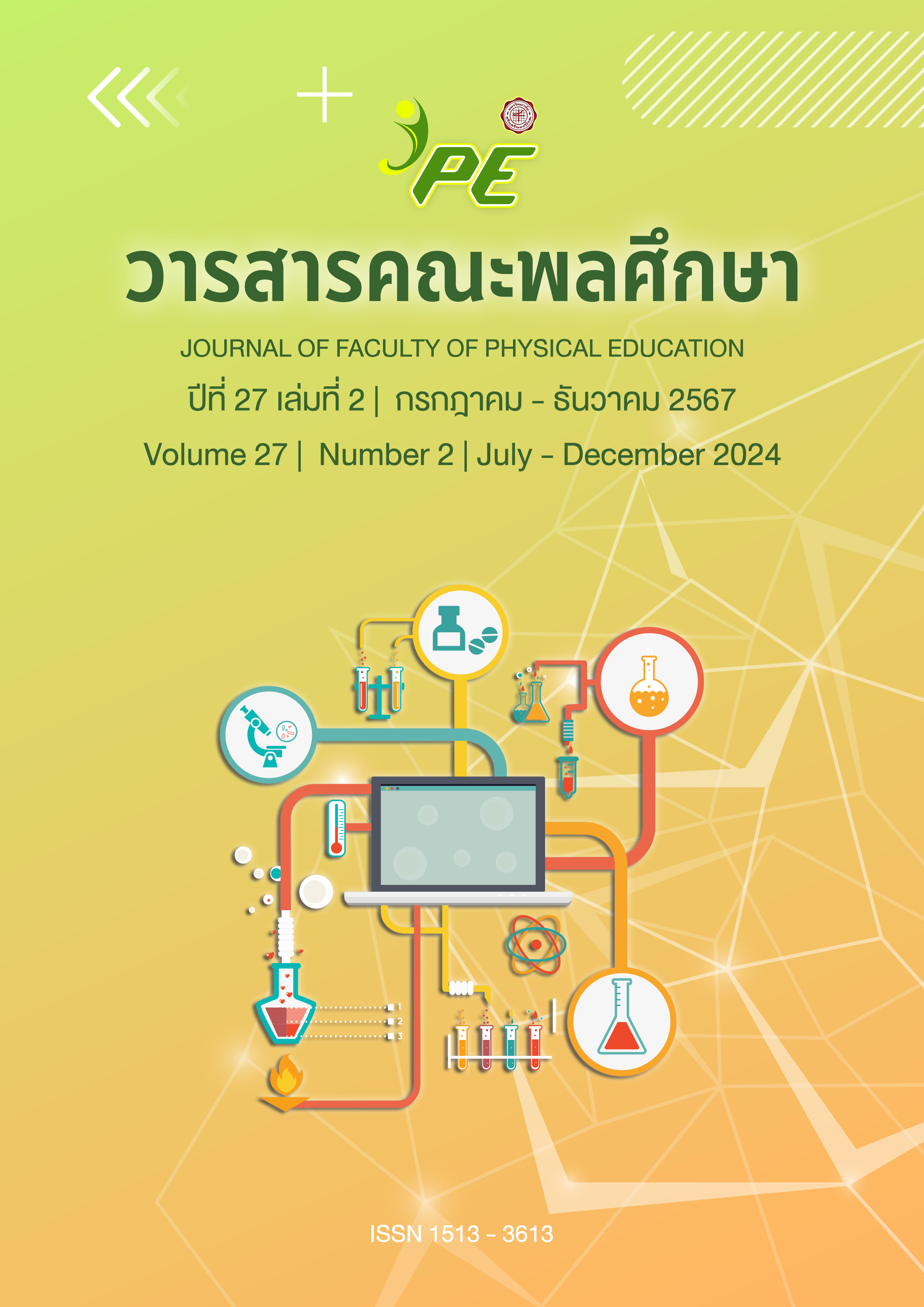The Effect of Phyometric and Weight Training on Leg Power and Strength of Athlete Rowing Thailand National Sports University Chiang Mai Campus
Main Article Content
Abstract
Abstract
The porpose of this research was to study and compare the effects of plyometric training programs along with weight training on the power and strength of the leg muscles, and to study the relationship between leg muscle power and leg muscle strength. The sample was male rowing athletes affiliated with the National Sport University Chiang Mai Campus. 20 people, divided into experimental and control groups. The research instrument is a plyometric training program coupled with weight training that affects the power and strength of the leg muscles of rowing athletes and the leg muscle power test instrument and the leg muscle strength tester. Perform data analysis by averaging standard deviations. Iterative one-way analysis of variance Statistics are tested in two groups independently and correlation analysis is performed. The results of the research were as follows:
- The effects of plyometric training programs coupled with weight training between experimental and control groups It was found that the leg muscle power test results of the experimental group. After weeks 4, 6 and 8 the average was 2333.30, 2540.90, and 2723.30 watts, respectively. Leg muscle strength test results in the experimental group After weeks 4, 6 and 8 the average was 125.90, 136.60 and 141.15 kilograms, respectively.
- The results of the comparison of leg muscle power and leg muscle strength between the experimental and control groups It was found that there was no difference between the experimental and control groups before training. After weeks 4, 6 and 8 there was a statistically significant difference between the experimental and control groups at .01, with leg muscle power test statistic values of 2.825, 3.951, and 5.975, respectively, and leg muscle strength test statistics of 3.453, 6.403, and 7.736, respectively.
- Correlation analysis using Pearson correlation coefficient to test the relationship between leg muscle power and leg muscle strength in the experimental group. After week 4 training, there was a significant correlation at .05 with a correlation coefficient of 0.690, after week 6 training there was a significant correlation at .05 with a correlation coefficient of 0.673, and after week 8 training there was a statistically insignificant correlation, respectively.
Keywords: leg muscle power, leg muscle strength, leg muscle power relationship, leg muscle strength and leg muscle strength
Article Details

This work is licensed under a Creative Commons Attribution-NonCommercial-NoDerivatives 4.0 International License.
Any articles and comments This journal is the opinion of the author. The Faculty of Physical Education doesn't always have to agree. Anyone wishing to publish or distribute a message must obtain direct permission from the author.
References
American College of Sports Medicine. (2018). ACSM’s Guidelines for Exercise Testing and Prescription. 10th
Edition.
Ngowtrakul, B. (2017). Increasing lower extremity muscle strength and the speed of sit-to-stand by using a motor
imagery control combined with exercise program in older adults: Electromyography and
electroencephalography studies (Doctoral dissertation), Chiang Mai University.
Wannamanee, C. (2006). Effects of plyometric training on leg muscle speed and power. independent research for
Master of Science, Sports Science, Chiang Mai University.
Concept2. (2018). Rowing is a Leg Sport. Retrieved October 15, 2020 From
https://www.concept2.com/news/rowing-leg-Sport-
?fbclid=IwAR2wipz0jzIaY49CUOV6OZ_e03u7jC4Y8JlN2ZBu1662veHky3aVicX9i7s.
International Rowing Federation (FISA). (2018). World Rowing Coaching Manual.
Phurungruang, K. (2005). Effects of leg muscle strength training on weight throwing
in judo athletes. independent research for Master of Science, Sports Science Chiang Mai University.
McNeely, E. (2016). Rowing Stronger: Strength Training to Maximize Rowing Performance.
Prasertsuk, N. (2015). Small-n Experimental Research Design. Silpakorn Educational Research ournal,7(1), 9-25.
Kongkitma, P. (2017). Effects of a plyometric training program on the muscle power and Basketball skills of Young
Male Athletes Studying at Traimit College. Master of Education Thesis ( Physical Education). Graduate
School Kasetsart University. Bangkok.
Redden, J. (2019). Assessing Lower Limb Strength, Power and Asymmetry in Elite Soccer Players using the
Keiser Air420 Seated Leg Press. University of Bath.
Hiranrat, S. (1992). Physical fitness training. Basic sports medicines. Bangkok: Siriraj Nursing Mahidol University.
Silamad, S. (2004). Principles of sports training for sports coaches. Bangkok: Chulalongkorn University.
Silamad, S. (2017). Principles of sports training for sports coaches. (5th Edition). Bangkok: Publisher of
Chulalongkorn University.
Pluemsamran, T. (2000). Sports Medicine: teaching materials for the Physical Education 422. Bangkok:
Department of Physical Education, Srinakharinwirot University, Prasarnmit.
Chansem, W. (2015). Air cylinder muscle power training tools. Academic journal Institute of Physical
Education,193-198.
Sondee, W. (2008). Effects of plyometric training combined with weight training on leg muscle power. Master's
degree in Education Thesis. (Physical Education). Bangkok: Graduate School, Srinakharinwirot
University.
World Rowing. (2021). World Rowing Statutes and Related Bye-Law. From


